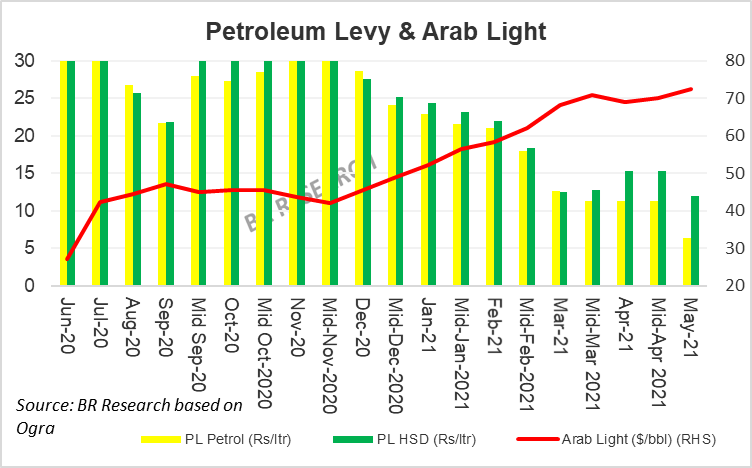The inflation pressure is telling on the government. The benchmark Arab Light crude oil price for the first May fortnight averaged $72.4/bbl – highest since December 2019. The base price for petrol at Rs75.8/ltr was highest since May 2019. Yet, the government could find any room to pass on the impact and instead continued to take the hit on Petroleum Levy (PL).
The Petroleum Levy for the first fortnight of May 2021 has been slashed to as low as Rs6.39/ltr. It was as recent as November 2019, where the government was charging PL to the fullest at Rs30/ltr. Had it not been for a much stable currency, things could have been worse in terms of PL collection. This space had flagged earlier that with every dollar that increases in the Brent price, the government will feel the heat, and the PL would be sacrificed.

Recall that the petroleum prices are still higher in year-on-year terms, which will keep showing in the inflation numbers. Around Rs6/ltr was prescribed to be increased in both HSD and petrol prices. The inability to do so means the PL on both products has been slashed considerably. The PL on HSD will be made public soon, but it is fair to estimate that it will have gone down to a multi-month low as well – at around Rs12/ltr.
The PL for gasoline at current rate is the lowest since November 2018 and the second lowest since the government assumed power. It must be remembered that the government had achieved significantly more (60%) than it had hoped for, in the first half of the fiscal year in lieu of PL collection target, chasing a rather optimistic annual target of Rs450 billion.

Ever since, things have slowed down considerably. And if 4QFY21 petroleum consumption numbers are not abnormally higher, Islamabad should be looking at achieving no more than 85-87 percent of the PL target. But the PL target, it appears, is not anywhere near the top priority list, as inflation concerns continue to haunt the incumbents.
Pakistan finds itself in the midst of a rather worrying Covid surge and that could essentially mean restricted movement, leading to lower-than-normal consumption for the remaining months of the fiscal year. This is where an assurance of Rs511 billion from the authorities to the IMF borders on ridiculous, so close to the end of the year.

There may be hope in terms of oil price relief as India’s catastrophe has raised demand concerns and could push oil prices back. That said, there is no way the government is getting anywhere close to Rs607 billion PL collection in the next fiscal, as communicated to the IMF. Every day that passes by is a day closer to the next general election. With all the recent changes aimed at tackling inflation, it is hard to see how there will be room for such high tax incidence on petrol. And this should also serve as a wakeup call to the tax authorities to actually start thinking through of avenues to collect taxes from, when the easy avenues close down.






























Comments
Comments are closed.